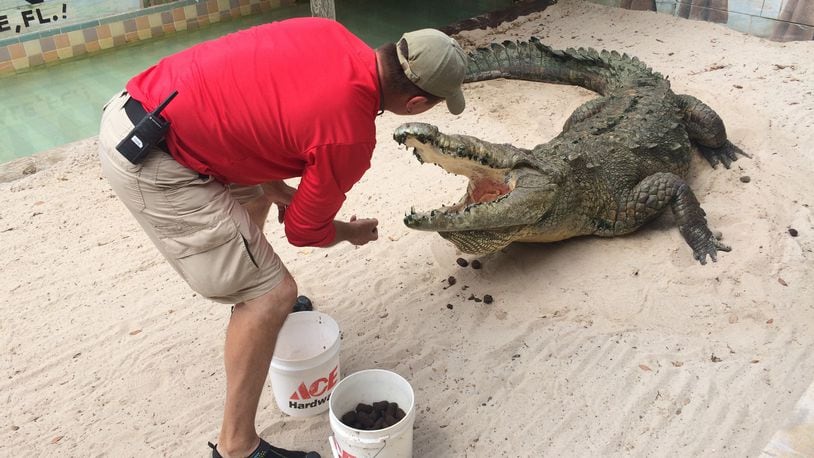They don’t mix, though, with a population of nearly 30 American crocodiles to the right and 35-40 American alligators to the left. The boardwalk has two spaces that jut off the main gangway.
That’s where curator Greg Graziani proceeds with feeding time, serving up raw chicken held with a blue latex glove that comes pretty close to hungry lunging teeth amid tales of the park’s history, one of Florida’s roadside attraction survivors that opened in 1957. He also serves up crocodile crunch, which visitors can buy for $3 a bag as well, a biscuit of sorts that reptiles dig.
The gators get fed in the late morning. The crocs in the afternoon. This private park, like Gatorland, can do a few things zoos don’t or won’t, including the “Fast Hands or No Hands” visitor feeding experience for $19.99. There’s also “Gator Bare Backin’ ” for $8 that lets visitor pose for photos while astride a 7- to 8-foot gator and holding its mouth shut and also “Uncle Waders Catch a Gator Pond,” also for $8, where visitors can wrangle some tiny juvenile alligators whose mouths are taped shut.
Watching the feeding, though, is free, as is a photo opportunity where visitors get to touch a live baby alligator. Also free are the dozens of display pens for animals at the back of the park.
That includes the star of Gatorama, who can’t live with the other crocodiles anymore. Goliath is missing part of his tail, but would be about 16 feet long. He came to the park in 1968, already a young adult, but over time became known as “Killer Croc” because he ended up killing many other alligators and crocodiles on site. At the time, the two were mixed in the front lake. Now he’s separated in his own pen in the back.
Also nestled in the back of the park are hundreds of other alligators of varying ages as well as other related species including caiman, African crocodiles, snapper turtles, African tortoises and more. There’s also a Florida panther pen, farm animals such as goats and some pretty ostentatious peacocks.
When the free-roaming peacocks with their long tail feathers tucked back slink along in your peripheral vision in a park that’s filled with alligators, you’re bound to do a double take and make sure it’s not a reptile on the loose.
The park is a working alligator farm with more than 2,000 animals from eight crocodilian species on site. While still recovering from hurricane damage from 2017, it’s growing its footprint, including the construction of a snack bar that park owners hope will be up and running before its annual Hatching Festival from Aug. 19-Sept. 4.
It’s a little rough on the edges compared to the more popular Gatorland in Orlando, but it has a lot of character that makes it a survivor.
———
ABOUT GLADES COUNTY
Population (as of 2015): 13,970
Major city: Moore Haven
Tourism bureau website: visitglades.org
Top restaurants:
Cafe Twenty Seven: facebook.com/CafeTwentySeven27
Antojitos: facebook.com/AntojitosMexicoLindo
Top attractions:
Okeechobee Airboat Charters: tripadvisor.com
Top hotels:
Rice's Motel: tripadvisor.com
IF YOU GO
Gatorama
U.S. Highway 27, Palmdale, Fla.
863-675-0623
About the Author
